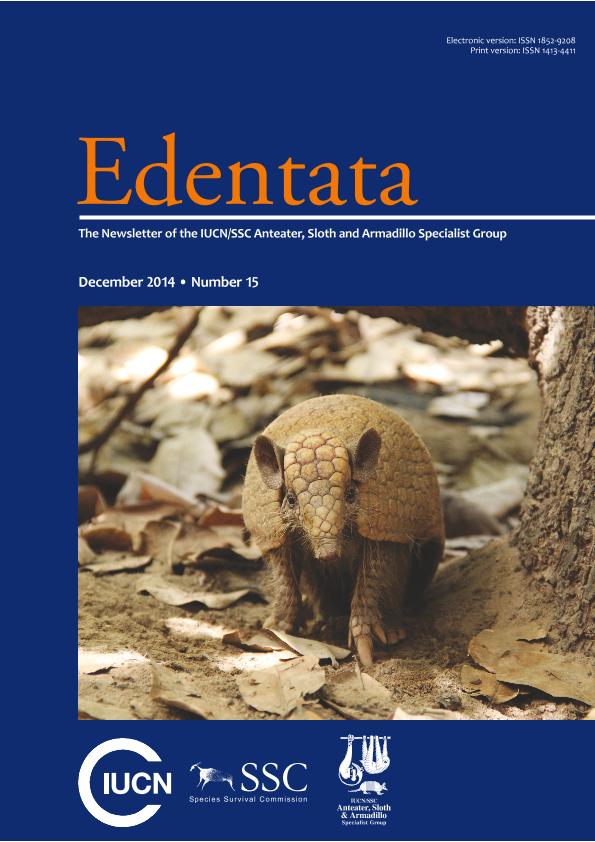Artículo
Muchos mamíferos son capaces de percibir y responder al riesgo de depredación a partir de señales emitidas por sus depredadores, aún en ausencia de una experiencia ecológica, evolutiva e incluso de ambas. Sin embargo, se ha propuesto que el cautiverio puede afectar dicho comportamiento debido probablemente a los costos que acarrean para las presas el conservar las conductas antidepredatorias. En el presente trabajo se analizó la respuesta de osos hormigueros (Myrmecophaga tridactyla) mantenidos en zoológicos (n=7) al ser expuestos a estímulos olfativos y auditivos de un depredador natural (yaguareté, Panthera onca). Para ello se comparó la respuesta comportamental que tenían frente a heces y vocalizaciones de yaguareté con aquella desplegada frente a señales de aguará guazú (Chrysocyon brachyurus), un carnívoro simpátrico no-depredador, y oveja (Ovis aries), una especie inocua alopátrica. Los resultados mostraron que los osos hormigueros en cautiverio conservan la capacidad de responder y discriminar entre los tratamientos, principalmente sobre la base de las vocalizaciones, pero que tras largos períodos de aislamiento las conductas antidepredatorias pueden verse alteradas, incompletas o incluso faltar. A pesar de que estos son resultados preliminares, el experimento apoya la hipótesis del mantenimiento de la respuesta antidepredatoria en los osos hormigueros mantenidos en cautividad que puede ser de suma importancia a la hora de definir estrategias para la reintroducción de animales criados en cautiverio y la reconstrucción de ecosistemas que incluyan poblaciones de esta especie. Many mammals are able to perceive and respond to predation risk from signals produced by their predators, even in the absence of an ecological or evolutionary experience, or both. However, it has been proposed that captivity may affect such behavior, probably due to the unnecessary costs related to preserving the antipredatory responses in that condition. In the present work we analyzed the response of captive anteaters (Myrmecophaga tridactyla; n=7) exposed to olfactory and acoustic stimuli from a natural predator (jaguar, Panthera onca). We compared the behavioral response of anteaters exposed to jaguar feces and vocalizations with those displayed when exposed to maned wolf (Chrysocyon brachyurus) and sheep (Ovis aries) signals. The maned wolf represents a sympatric carnivorous species that does not predate on anteaters, and the sheep represents an allopatric herbivorous non-predator species. The results showed that the anteaters in captivity retain the capability to respond to and discriminate between the different treatments, mainly when exposed to vocalizations. Despite this, the antipredatory behaviors may become altered, incomplete or even lacking after large periods of isolation. Even though these are preliminary results, the experiment supports the hypothesis that captive anteaters are able to retain some predator recognition ability, and this result could be relevant when defining strategies for the reintroduction of captive-reared animals and the restoration of ecosystems that hold populations of this species.
Respuesta Antidepredatoria de Osos Hormigueros (Myrmecophaga tridactyla) Mantenidos en Cautividad
Título:
Antipredatory behavior of giant anteaters (Myrmecophaga tridactyla) in captivity
Fecha de publicación:
12/2014
Editorial:
Anteater, Sloth and Armadillo Specialist Group
Revista:
Edentata
ISSN:
1413-4411
e-ISSN:
1852-9208
Idioma:
Español
Tipo de recurso:
Artículo publicado
Clasificación temática:
Resumen
Palabras clave:
Claves
,
Respuesta Antidepredatoria
,
Evitación
,
Escape
Archivos asociados
Licencia
Identificadores
Colecciones
Articulos(IEGEBA)
Articulos de INSTITUTO DE ECOLOGIA, GENETICA Y EVOLUCION DE BS. AS
Articulos de INSTITUTO DE ECOLOGIA, GENETICA Y EVOLUCION DE BS. AS
Citación
Fernandez, Gustavo Javier; Orlando, Cristian Gabriel; Respuesta Antidepredatoria de Osos Hormigueros (Myrmecophaga tridactyla) Mantenidos en Cautividad; Anteater, Sloth and Armadillo Specialist Group; Edentata; 15; 12-2014; 52-59
Compartir
Altmétricas




